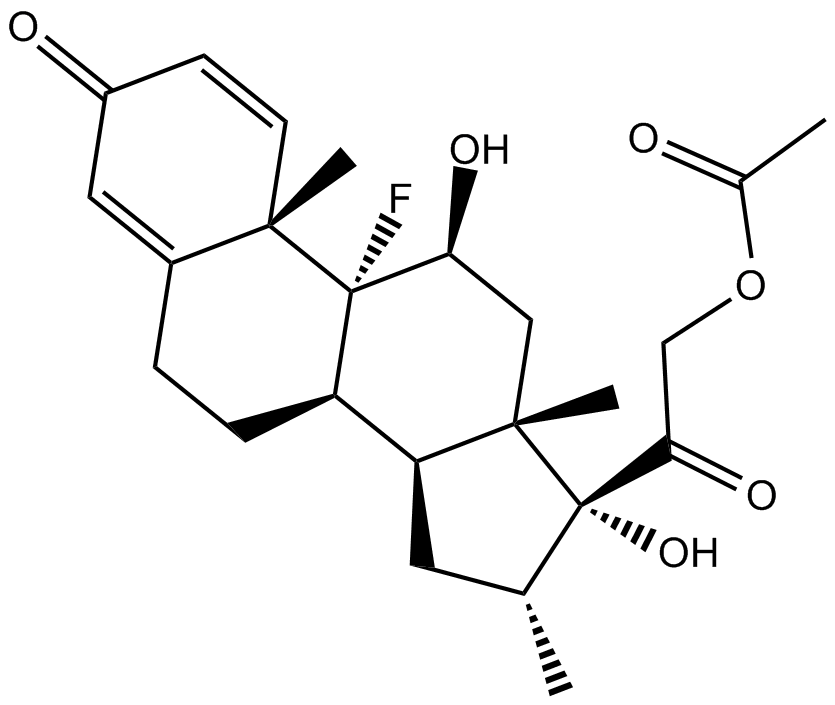Dexamethasone acetate (Synonyms: NSC 39471) |
| カタログ番号GC11237 |
デキサメタゾン アセテート (デキサメタゾン 21-アセテート) はグルココルチコイド受容体アゴニストです。
Products are for research use only. Not for human use. We do not sell to patients.

Cas No.: 1177-87-3
Sample solution is provided at 25 µL, 10mM.
Dexamethasone acetate is a glucocorticoid receptor agonist.
Dexamethasone regulates several transcription factors, including activator protein-1, nuclear factor-AT, and nuclear factor-kB, leading to the activation and repression of key genes involved in the inflammatory response[1]. Dexamethasone potently inhibits granulocyte-macrophage colony stimulating factor (GM-CSF) release from A549 cells with EC50 of 2.2 nM. Dexamethasone (EC50=36 nM) induces transcription of the β2-receptor is found to correlate with glucocorticoid receptor (GR) DNA binding and occurred at 10-100 fold higher concentrations than the inhibition of GM-CSF release. Dexamethasone (IC50=0.5 nM) inhibits a 3×κB (NF-κB, IκBα, and I-κBβ), which is associated with inhibition of GM-CSF release[2].
It has previously been reported that treatment with Dexamethasone at a dose of 2×5 mg/kg efficiently inhibits lipopolysaccharide (LPS)-induced inflammation. In our experimental system, treatment with a single dose of Dexamethasone 10 mg/kg (i.p.) significantly decreases recruitment of granulocytes as well as spontaneous production of oxygen radicals compared with animals expose to LPS and injected with solvent alone (saline). The effects are statistically significant when administered both 1 h before and 1 h after inhalation of LPS. The number of granulocytes in BALF decreased to levels comparable to healthy animals (given an aerosol of water)[3]. Rats treated with Dexamethasone consume less food and weighed less than control rats. Treated rats also weigh less than pair-fed animals though their food intake is similar. Five days of Dexamethasone injection result in a significant increase in both the liver mass (+42%) and the liver to body weight ratio (+65%). The wet weight of gastrocnemius muscle decreases 20% after 5 days of treatment, but it remains unaffected relative to body weight (g/100 g body weight), indicating that muscle weight loss paralleled body weight loss[4].
Reference:
[1]. LaLone CA, et al. Effects of a glucocorticoid receptor agonist, Dexamethasone, on fathead minnow reproduction, growth, and development. Environ Toxicol Chem. 2012 Mar;31(3):611-22.
[2]. Adcock IM, et al. Ligand-induced differentiation of glucocorticoid receptor (GR) trans-repression and transactivation: preferential targetting of NF-kappaB and lack of I-kappaB involvement. Br J Pharmacol. 1999 Jun;127(4):1003-11
[3]. Rocksén D, et al. Differential anti-inflammatory and anti-oxidative effects of Dexamethasone and N-acetylcysteine in endotoxin-induced lung inflammation. Clin Exp Immunol. 2000 Nov;122(2):249-56
[4]. Roussel D, et al. Dexamethasone treatment specifically increases the basal proton conductance of rat liver mitochondria. FEBS Lett. 2003 Apr 24;541(1-3):75-9.
Average Rating: 5 (Based on Reviews and 4 reference(s) in Google Scholar.)
GLPBIO products are for RESEARCH USE ONLY. Please make sure your review or question is research based.
Required fields are marked with *




















